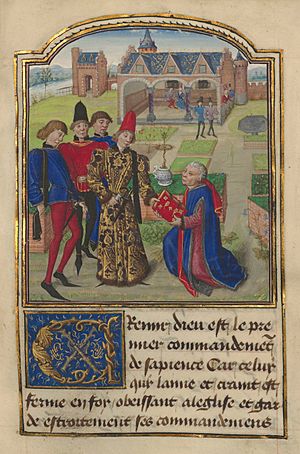Georges Chastellain facts for kids

Georges Chastellain (born around 1405 or 1415 – died 1475) was an important writer from the Duchy of Burgundy. He was known for writing history (a chronicler) and for his poems. He was born in Aalst, a town in Flanders. His historical writings are very useful because they contain accurate information about his time. As a poet, he was quite famous among people who lived when he did.
Contents
About Georges Chastellain
Early Life and Adventures
Georges Chastellain's family name came from his ancestors. They were important officials called burgraves or châtelains (like castle governors) in their town. His parents were from well-known Flemish families. He was likely born around 1415.
When he was young, Georges fought in the wars between England and France. He earned the nickname "L'adventureux" (The Adventurous) because of this. In 1434, Philip the Good, the Duke of Burgundy, gave him a gift for his military service.
After the war ended in 1435, he stopped being a soldier. He started working as a diplomat, which means he helped leaders talk to each other. For about ten years, he worked in France. He was part of the household of Pierre de Brézé, an important French official. Georges helped try to improve relations between the French King Charles VII and the Duke of Burgundy.
Working for the Duke of Burgundy
Later, when relations between the French king and the Duke of Burgundy worsened, Chastellain left France. He began working for Duke Philip the Good in Burgundy. He held titles like "pantler" (in charge of the pantry) and "carver" (who carves meat). But these titles were misleading. His real job was still that of a diplomat.
In 1457, he became a member of the Duke's special council. He continued to go on many diplomatic missions. Around 1455, because of poor health, he received a special apartment in Valenciennes. He also got a good pension. In return, he was asked to write "new and moral things" and a chronicle of important events. This meant he became the official historian for Burgundy.
Later Life and Writings
From this time on, Georges worked hard on his main historical work, the Chronique (Chronicle). He sometimes took breaks to go on missions or visit the Duke's court. From about 1463, his student, Jean Molinet, helped him.
Charles the Bold, who became Duke after Philip, also supported writers. He especially favored Chastellain. Georges was made the official historian for the Order of the Golden Fleece, a special knightly order. On May 2, 1473, he himself became a knight of this order.
Georges Chastellain died in Valenciennes in 1475. Only about one-third of his huge historical work, which covered the years 1419 to 1474, is still known today.
His Legacy and Style
Importance of His Work
During his lifetime, Chastellain was very famous for his poems and other writings. His Chronique was not printed for a long time after his death. But in 1825, a researcher named Jean Alexandre Buchon found his historical work in libraries.
Chastellain was involved in many talks between the French and Burgundian courts. This meant he knew a lot about the people and events he wrote about. Because he worked for Burgundy, his writings about French affairs sometimes showed a bias towards Burgundy. For example, his view of Joan of Arc was influenced by this.
His Writing Style
Georges Chastellain was not just someone who listed events. He wanted to shape his vast material into his own conclusions. He used his experience in politics to do this.
One of the most interesting parts of his work is how well he described the important people of his time. He was good at observing people. His descriptions often included funny or critical details. He called one chapter about his descriptions of people: "How Georges writes and mentions the virtuous praises of the princes of his time."
His French writing style was strong and vivid. It had a lot of detail and a formal, speech-like quality. This was typical of the Burgundian school of writers.
Main Works
- Chronique des choses de mon temps: This was a history of the years 1417–74. Only parts of it still exist. His student, Jean Molinet, continued it after Chastellain's death.
- "Louange à la tresglorieuse Vierge" (Praise to the Most Glorious Virgin): A poem written around 1455.
- Récollections des merveilles advenues en mon temps (Recollections of the Wonders that Happened in My Time).
- Chronique de Messire Jean de Lalaing: A biography about a knight.
See also
 In Spanish: Georges Chastellain para niños
In Spanish: Georges Chastellain para niños

